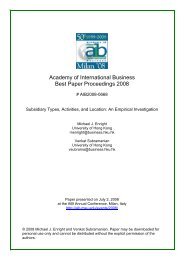AIB 2012 Conference Proceedings - Academy of International ...
AIB 2012 Conference Proceedings - Academy of International ...
AIB 2012 Conference Proceedings - Academy of International ...
You also want an ePaper? Increase the reach of your titles
YUMPU automatically turns print PDFs into web optimized ePapers that Google loves.
SUNDAY<br />
and core international-business topics genotypically, without mathematical models, by re-creating the topics in<br />
the context <strong>of</strong> the game. Attendees at the conference are encouraged to bring an Internet-accessible Windows<br />
computer to experience playing the game. Steps demonstrating how the game is played are described,<br />
accompanied by selected screen shots. Benefits to students, instructors, administrators, and researchers are<br />
discussed. Research conducted with games <strong>of</strong> this kind should contribute to advancing international-business as<br />
a discipline in its own right. (For more information, please contact: Precha Thavikulwat, Towson University,<br />
USA: pthavikulwat@towson.edu)<br />
Using Economic Indicators to Explore National Business Climates: An Experiential Exercise<br />
Josh Bendickson, Louisiana State University<br />
Eric W. Liguori, California State University, Fresno<br />
Here we present an experiential exercise for use in any Introductory <strong>International</strong> Business course. As part <strong>of</strong><br />
their 2011 Open Data initiative, World Bank has publically made available a plethora <strong>of</strong> economic and financial<br />
indicators from around the globe. The data catalog includes over 7,000 indicators spanning over 200 countries.<br />
Using this newly available data, student teams are tasked with analyzing various macro- and micro-economic<br />
indicators for two countries. To present the information gathered, students then employ Google Site technology<br />
to create an interactive presentation <strong>of</strong> the data. The Google Sites format challenges students to think about<br />
creative ways to use technology, and provides a challenging yet reasonable medium by which the country level<br />
data can be presented. The World Bank data challenges students to identify what factors are most relevant, and<br />
familiarizes them with what is arguably the leading source <strong>of</strong> global economic indicator data. Ultimately, this<br />
exercise is useful in explaining varying global environments, country differences, cross-border trade and<br />
investment, global competition, and data interpretation. (For more information, please contact: Josh<br />
Bendickson, Louisiana State University, USA: jbendi2@lsu.edu)<br />
Session: 1.3.11 - Interactive<br />
Track: 7 - Emerging Economies<br />
The Effects <strong>of</strong> Institutional Development on FDI in Emerging Markets<br />
Presented On: July 1, <strong>2012</strong> - 13:00-14:15<br />
Chair: Gladys Torres Baumgarten, Ramapo College <strong>of</strong> NJ<br />
State Capitalism and Clusters: The Case <strong>of</strong> Brazilian Shipbuilding<br />
Frank Latta DuBois, American University<br />
Marcos Andre Primo, Federal University <strong>of</strong> Pernambuco<br />
The success <strong>of</strong> the BRIC countries in weathering the economic downturn <strong>of</strong> the 2007 – 2010 period has<br />
generated attention on initiatives that governments take to enhance the competitiveness <strong>of</strong> strategic industries<br />
and to encourage the development <strong>of</strong> supporting enterprises. State capitalism is an economic model that relies<br />
on the role <strong>of</strong> a strong central government to support chosen firms and industries with subsidies, tax benefits<br />
and other advantages to which non-favored firms or industries do not have access (Bremmer 2010). From an<br />
economic development perspective state capitalism is <strong>of</strong>ten used to redirect economic activity to<br />
underdeveloped regions (Wickham 2009, Chobanyan and Leigh 2006, Porter 2008). Using Porter's diamond<br />
factor model we analyze the development <strong>of</strong> an economic cluster focused around the shipbuilding industry in<br />
northeastern Brazil. We pr<strong>of</strong>ile the investments and incentives that the government has made in this region<br />
with particular attention to the mechanisms and policy directives designed to support local involvement in<br />
cluster activity. We conclude with comments with regard to the applicability <strong>of</strong> this model to economic<br />
development activity in other country contexts. (For more information, please contact: Frank Latta DuBois,<br />
American University, USA: jetfrank@yahoo.com)<br />
<strong>AIB</strong> <strong>2012</strong> <strong>Conference</strong> <strong>Proceedings</strong><br />
Page 45

















